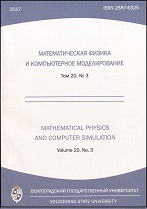|
Physics and astronomy
Numerical simulation of the thermal turbulence in the optical thick clouds of the interstellar medium
V. V. Korolev, M. A. Eremin, E. V. Zhukova, I. G. Kovalenko, A. M. Zankovich
Volgograd State University
Abstract:
We present the results of numerical modeling of convective instability developing in a protostar cloud in the framework of a two-dimensional self-consistent optical-hydrodynamical model of a turbulent gas-dust cloud taking into account the movement of the medium under the influence of its own gravity and radiation pressure.
The work [2] shows that in the presence of a constantly acting source of ultraviolet radiation in the central part of the self-gravitating gas-dust cloud, gas distribution in it takes the form of a shell:
hot rarefied gas is located in the central part, then comes a region with dense cold gas, and then on the periphery there is a gas with concentration and temperature asymptotically decreasing towards the edge. Such an inverse distribution of matter in the cloud is unstable. If local disturbances in the balance of gas and radiation pressure forces, on the one hand, and self-gravity, on the other, cause convection, then global turbulence may develop in the cloud over time. Therefore, with the characteristic parameters of the observed diffuse clouds in the interstellar medium, the cloud becomes convectively unstable and goes to a state with an inverse distribution of concentration and temperature.
The cloud is modeled as an infinitely long inhomogeneous gas-dust layer optically opaque and mirror-symmetric with respect to the equatorial plane. Stars that are sources of radiation are uniformly located along this plane. The cloud is supposed to be significantly more massive compared to the stars, therefore, the model takes into account only self-gravity of the gas-dust medium. We assume that the dust component of the cloud is less massive in comparison with the gas one, and we believe that the velocities of dust particles are adjusted to the gas flow velocity for times substantially shorter than the dynamic times of cloud evolution.
The two-channel approximation is used in the model of radiation transfer in a gas-dust cloud. The medium is effectively heated due to ultraviolet radiation in the range of $ 0 {.} 1$–$0 {.} 5 $ $\mu m$, since for these wavelengths the dust component of the medium has a large optical thickness. The energy of this radiation is partially converted into thermal and kinetic energy of the medium, and partially radiated by dust in the form of infrared radiation at wavelengths of $ \sim 100 \, \mu m$, for which the medium is transparent.
Convection arises in this inverse density distribution layer in the form of small-scale vortices. The sizes of the vortices reach $ \sim (0{.}05$–$0{.}1) \lambda_J$ ($\lambda_J$ is the Jeans length) with time, and the flow becomes turbulent throughout the entire thickness of the cloud. Turbulence developing in cloud is transonic with velocities of $\sim 600$ m/s and Mach numbers up to $1{.}2$, however, supersonic regions occupy a small part of the cloud volume.
Keywords:
interstellar medium, diffuse clouds, radiation transfer, turbulence, convection.
Received: 24.06.2019
Citation:
V. V. Korolev, M. A. Eremin, E. V. Zhukova, I. G. Kovalenko, A. M. Zankovich, “Numerical simulation of the thermal turbulence in the optical thick clouds of the interstellar medium”, Mathematical Physics and Computer Simulation, 22:4 (2019), 80–94
Linking options:
https://www.mathnet.ru/eng/vvgum269 https://www.mathnet.ru/eng/vvgum/v22/i4/p80
|

| Statistics & downloads: |
| Abstract page: | 44 | | Full-text PDF : | 16 |
|




 Contact us:
Contact us: Terms of Use
Terms of Use
 Registration to the website
Registration to the website Logotypes
Logotypes







 Citation in format
Citation in format 